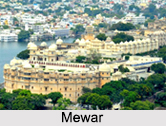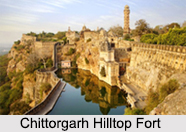 Mewar region is an area of south-central Rajasthan state in western India. It comprises the existing districts of Bhilwara, Chittorgarh, Rajsamand, Udaipur, Pirawa Tehsil, Jhalawar, Neemuch, Mandsaur of Madhya Pradesh and some parts of Gujarat. The area included former states of Udaipur, Shahpura and Pratapgarh.
Mewar region is an area of south-central Rajasthan state in western India. It comprises the existing districts of Bhilwara, Chittorgarh, Rajsamand, Udaipur, Pirawa Tehsil, Jhalawar, Neemuch, Mandsaur of Madhya Pradesh and some parts of Gujarat. The area included former states of Udaipur, Shahpura and Pratapgarh.
Location of Mewar
Mewar region lies between the Aravalli Range to the north-west, Ajmer to the north, Gujarat and the Vagad region of Rajasthan to the south, the Malwa region of Madhya Pradesh to the southeast and the Hadoti region of Rajasthan to the east.
History of Mewar
The origin of Mewar in the state of Rajasthan is rooted in mythology. The Ahar civilization of Mewar has been accepted as contemporary to the Indus Valley Civilization. In fact the Mewar dynasty traces its roots to the powerful Sun God and its history has been a continuous struggle for freedom of religion, thought and land against other Rajputs. Mewar remained in Mughals hands for about 150 years. It was a Rajput kingdom for several centuries and in the later ages became a Princely State under the British colonial rule.
 Geography of Mewar
Geography of Mewar
The northern and eastern parts of Mewar are made up of an important plateau while the western and southern portions are stony and hilly with dense forests. The cut-off point split between drainage of the Bay of Bengal and drainage of the Gulf of Khambhat runs almost throughout the middle of Mewar. The area is a part of the Kathiawar-Gir dry deciduous forests eco-region.
Culture and Traditions of Mewar
Music has deeply ingrained in the lives of the people of Rajasthan and especially that of Mewar. Shopping in Mewar also proves to be an enchanting cultural experience as the brilliant land glitters with vibrant hues of elaborate handicrafts. The regal pleasure of shopping for articles ranging from folk toys to Bandhni textiles, mirror work crafts to beadwork crafts, traditional Pichwai or Miniature paintings on cloth to colourful puppets and cloth lanterns, metal craft or terracotta work, Mewar surprises you with the availability of all.
Festivals of Mewar
The Mewar festival is celebrated in the region to welcome the advent of the spring season. It coincides with the Gangaur festival of Udaipur, another popular town of Rajasthan. This festival has a unique charm about it. During this auspicious occasion, the women folk gather to adorn the images of Isar and Gangaur and then carry them in a ceremonial procession in which all the locals participate with much enthusiasm and vigour and then winds its way to the Gangaur Ghat at Lake Pichhola.
Economy of Mewar
Main crops of Mewar consist of maize, groundnut, soybean, wheat and mustard. Fishery also blooms in the region`s different lakes, supported by a government fisheries division. The economy of the Mewar region relies mainly on tourism, the marble and stone industry, mining, handicrafts, zinc smelters, cement and tyre factories, as well as farming.
Tourism in Mewar
Mewar region has a number of tourist attractions. Chittorgarh Hilltop Fort is one of the major tourist attractions of Mewar. The fort is a representation of Rajput culture and values. The Lake Palace is a palace established in 1746. It is totally made of marble and located in the middle of Lake Pichola. Kumbhalgarh is another famous tourist attraction in Mewar region. It is a fortress of 15th century, built by Rana Kumbha. Other attractions are Ranakpur village, Rajsamand, Charbhuja Temple, Haldighati, Eklingji, Fatehsagar Lake, Jaisamand Lake etc.
Visiting Information of Mewar
Public bus services, operated by Rajasthan Roadways are available from all the major cities of Rajasthan . Trains from main capital cities run to and through Udaipur Railway Station. Jaipur, Delhi, Ajmer are the nearest stations. The Maharana Pratap Airport or Udaipur Airport or Dabok Airport is the nearest airport.



















